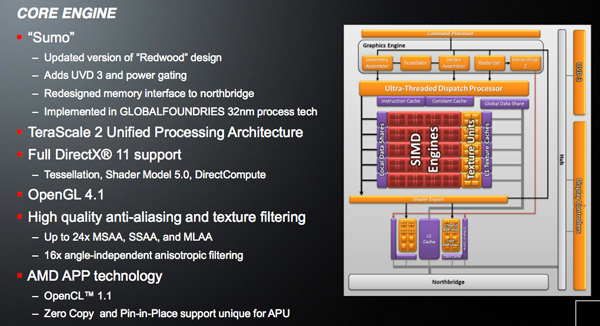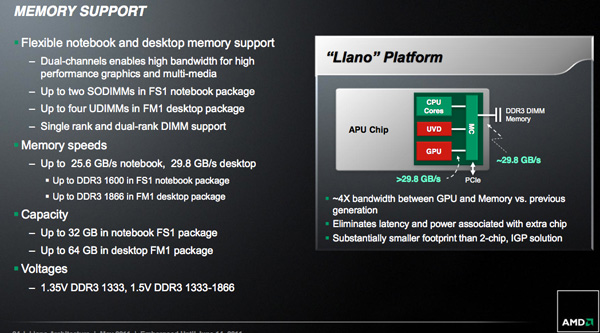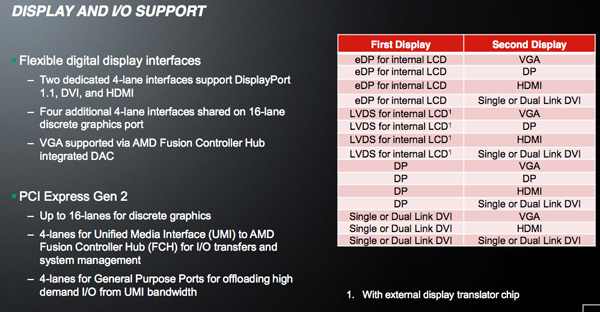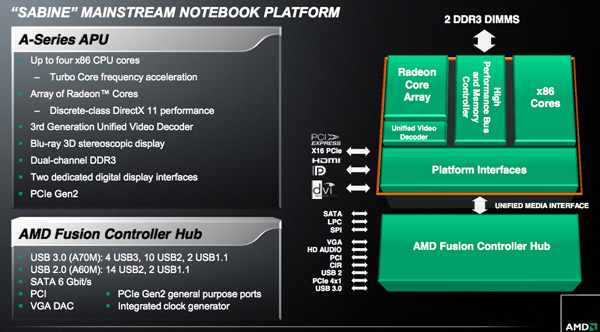The AMD Llano Notebook Review: Competing in the Mobile Market
by Jarred Walton & Anand Lal Shimpi on June 14, 2011 12:01 AM ESTThe GPU
While the Llano CPU cores may be in need of a major overhaul, Llano's GPU is as new as it gets. Technically based off of AMD's Redwood core (Radeon HD 5570) with some enhancements, Llano's GPU is codenamed Sumo.
The DX11 GPU features five SIMD arrays, each with 80 cores for a total of 400 shader processors. Similar to the updates we saw with this year's Northern Islands GPUs, Sumo does add UVD3 support to the Redwood architecture. Of course since Sumo shares the same die as the Llano CPU cores it is built on GlobalFoundries' 32nm process, making this the first AMD GPU fabbed at GlobalFoundries and not TSMC.
For everything behind the memory controller Sumo is virtually identical to Redwood. Where Sumo differs is in its memory interface. Although Llano is AMD's first performance oriented APU, it's still constrained by a 128-bit wide DDR3 memory interface. That dual-channel memory interface has to be shared by all four Llano cores as well as the Sumo GPU and as a result, arbitration is very important.
AMD shared a few choice details about the Llano memory controller architecture. To begin, AMD guarantees more than 30GB/s of bandwidth is available between the GPU and the memory controller—in other words, the path from GPU to the memory controller won't become a bottleneck. The GPU/memory controller link (i.e. within the APU die) can apparently scale up to as much as 50GB/s to support future APUs with even faster memory interfaces. Note that unlike previous integrated graphics solutions, there is no support for dedicated external memory—this is a pure shared memory architecture.
Second, and most importantly, AMD can dynamically prioritize memory bandwidth between the CPU and GPU. In most cases, when both processors are heavily consuming data, the GPU is given priority over the CPU. Given today's workloads, prioritizing the GPU for memory accesses makes sense when it's running full tilt. The chances of you stressing all four CPU cores and running at full GPU memory bandwidth requirements are pretty slim today.
With 400 shader processors behind a shared 128-bit DDR3 memory interface, the upper bound for Sumo performance is the Radeon HD 5570. In practice, you should expect performance to be noticeably lower since the GPU does have to share its precious memory bandwidth with up to four x86 CPU cores.
The mobile version of Llano supports up to DDR3-1600 while the desktop parts can run at up to DDR3-1866. Maximum memory capacities are 32GB and 64GB for notebooks and desktops, respectively.
Llano has a total of 24 PCIe Gen 2 lanes at its disposal. Sixteen of those lanes can be used for external graphics. Four of the lanes can be used for devices that need low latency/high bandwidth access to the APU itself (e.g. Gigabit ethernet). The remaining four lanes are used to connect the APU to its sole partner in crime: the Fusion Controller Hub.
AMD is particularly proud of the display output configurations supported by Llano. The possible combinations are listed below:
Chipsets
AMD will offer two Fusion Controller Hubs (FCHs) as options for Llano: A70M and A60M. The only difference between the two is in their support for USB 3.0; the A70M has four USB 3.0 ports while the A60M has none.
Both FCHs support 6Gbps SATA and perform just as well as AMD's 8-series chipset (or Intel's Z68) with a high performance SSD. USB 3.0 performance is also comparable to 3rd party solutions we've seen deployed on motherboards already.















177 Comments
View All Comments
jollyjugg - Saturday, June 18, 2011 - link
Anand,you are making such a big deal of performance between Intel and AMD machines. Most of the folks who buy laptops are not looking to a super computer level performance which matters a lot in the server world or may be even desktop world. They are looking to buy a laptop which has good performace, good battery life and are more affordable. For the kind of applications most of the people use (internet surfing, listening to musing, watching youtube, watching movies, playing solitaire etc etc), thre will hardly be any difference between the offerings from both manufacturers. The fact that you are comparing performance and battery life and rather sneeringly say that if you want a machine which is 100-200 bucks lower then you should go for Llano machine at the cost of less performance makes me see black here. Why is cost not a big deal for you. How can you absolutely say that intel performance/$ and Battery life/$ is better than AMD's metrics. If not for AMD intel will be selling these machines not for 700 but for 1000. So in reality customers see reduced cost from Intel and a further 200 discount on AMD machines. You have to be a bit impartial in your reviews and not make only big deal of performance in portable machines where battery life and cost is also equally important and compare them as such. The fact that Intel's peformance is important win for them over AMD performance is a important one for geeks and enthusiasts like you, but not for comman man in the street. For him bang for the buck is the most important metric in most of the cases. But since your website is a reputed one, whatever you say might influence the opinion of man in the street. Please dont let your or any of your staff's personal opinion cloud their ability to see the bigger picture and tell it as such to PC buyers. Be impartial in your reviews.
A Humble AMD Fan
JarredWalton - Saturday, June 18, 2011 - link
We do our best to remain impartial; if we were partial, we would strongly advocate for or against AMD. When someone calling themselves a "humble AMD fan" talks about being impartial, you've pretty much already shot yourself in the foot. I'm not an Intel fan, despite what many would like to say. Right now, Intel simply has the better processor. AMD now has the better all-in-one design if you value graphics performance, but in order to give AMD the win you have to declare GPUs as being more vital than CPUs. Right now, outside of gaming, we're missing the killer apps to make that true.What we said here is that AMD is competitive with Llano, and they are, but the pricing is really the big question. We *guess* that you might get AMD laptops for $100 to $200 less than Intel, but that's being generous. AMD says the laptop used in this review should have a target price of around $800 (because it has the 6630M in addition to Llano). At that price, this is not a clear win for AMD--not even close. Yes, Intel would be priced differently if AMD didn't exist, but you can't judge the quality of a product by what would happen if it disappeared. "Duke Nukem Forever would be an amazing game if no other FPS titles had come out in the past 15 years!"
For $800, ASUS already has the U41JF with similar graphics performance and better battery life (mostly because of the larger battery, but that's still important). Besides the MSI CX640 (i3-2310M with GT 520M for $650), there are five other laptops at Newegg that have Optimus graphics and Arrandale CPUs for under $750 (and in terms of performance, Llano is still slower than Arrandale on the CPU side). For $900, you can get a Samsung laptop with i7-2630QM and Optimus GT 540M. Dell's XPS 15 can be had with an i5-2410M and Optimus GT 525M for $800. That's what AMD has to compete with, and right now every one of those is significantly faster than Llano, offers better graphics performance than the Llano IGP, and battery life is similar or slightly worse.
Last year when I ripped on AMD's laptops for having okay performance with horrible battery life, AMD fans tried to tell me battery life didn't matter. We were looking at 2.5 hours with Athlon II/Phenom II compared to 5+ hours for Arrandale, and it "didn't matter" because people just wanted what was cheaper. Now we're looking at 6-7 hours battery life for Intel compared to 7-8 hours for Llano, at a similar price (at least going by AMD's suggestion), and battery life has suddenly become a lot more important. I recognize hypocrisy when I see it....
In summary, once more: Llano is a good step forward, but it will really depend on pricing. It cannot compete at $800. Period. Core i5-2410M is already 30-50% faster on the CPU side, offers similar battery life, and can be had with an Optimus GPU for $800. If AMD can't beat the performance or battery life, the only thing they can do is reduce pricing, so A8-3500M will need to start closer to $600, not $700. The A8-3530XM is the fastest mobile Llano chip, and it's only clocked 27% higher than the A8-3500M, likely with a $50 price premium (at least), so we can't really take that as a potential win either. 3530MX for $700 on it's own (no dGPU) would be reasonable, though, which is why I say that 3500M needs to be at the $650 (or lower) price range.
There's still the matter of getting a good quality laptop, regardless of whether it's AMD or Intel based, and that has been a seriously weak area for inexpensive laptops. Personally, if I were going out and spending my own money on a laptop right now, I'd lean heavily towards business offerings (Dell Latitude, Lenovo ThinkPad, or HP ProBook/EliteBook), just because their keyboards and build quality are so much better. That means I would be paying $1000+ for even a moderate laptop, and at that price it's no surprise that all the business offerings use Intel's CPUs. You can go the other route and buy an okay $600 laptop today, and in 18 months you replace it with another $600 laptop; the only problem is you're stuck with the crappy keyboards if you do that.
If there's any bias in my above statements, please let me know where. About the strongest bias I express is for good build quality and keyboards -- chiclet need not apply. AMD or Intel really doesn't matter to me; the question is who can offer the more compelling package overall, and determining a winner there requires listing out all the various aspects and then making a personal decision. I won't say that a faster CPU is always superior, just as a faster APU/GPU isn't always superior. They're different is all, but looking at the entire market right now the CPU will win out for the majority of users. Remove all the teenagers and 20-somethings from the population, and I'd say gamers (like myself) are less than 10% of the notebook buying population. Even with the younger generation included, I'd still say only 20% of laptops purchased will ever run anything more complex than Facebook games.
mga318 - Sunday, June 26, 2011 - link
Well, we can look at prices now.HP is currently selling their 15 inch dv6z laptop with the same processor as this one for $659 without the additional graphics card. Which means that your statement of these laptops needing to be priced closer to $600 is right on the money for what we're getting. Likewise, HP's upgrade to AMD's fastest APU is precisely what you guessed $50. So that places the A8-3530XM right at $709 without an additional graphics card. HP doesn't say exactly what card they're offering for their $50 and $100 dollar upgrades, but they're both listed as having GDDR5 instead of your DDR graphics card here:
512MB GDDR5 Radeon(TM) HD Dual Graphics [HDMI,VGA]
+$50.00
1GB GDDR5 Radeon(TM) HD Dual Graphics [HDMI, VGA]
+$100.00
So now you're getting the premium processor and graphics card for $809 (assuming you stay with the other standard components, with are 6GB RAM (speed not listed) and a cheapo 500GB 5400 RPM hard drive.
What do you think, Jared, are those competitive enough prices?
mga318 - Sunday, June 26, 2011 - link
*which are (not "with are").choikwa - Wednesday, June 29, 2011 - link
512MB GDDR5 Radeon(TM) HD Dual Graphics [HDMI,VGA]+$50.00
[6400m]
1GB GDDR5 Radeon(TM) HD Dual Graphics [HDMI, VGA]
+$100.00
[6700m]
You can verify these as
choikwa - Wednesday, June 29, 2011 - link
6400m has 160 stream procs6700m has 480 stream procs
rick1725 - Thursday, June 30, 2011 - link
Is this place full of Intel fanboys or what? The e-350 is far superior to any Atom configuration available. This has been proved over and over again. Stop flamming and get you head out of Intels overpriced a**strawhat pirates - Wednesday, July 13, 2011 - link
baka...baka...bakaaaa!!! <--- japan language... mention it to you, rick1725!!intel only win on advertising alone ...
the rest? thumbs down for InteLosers!! #boooo ...
and intel is only a theory core ...*core fuck!! there is no definite proof .. :@
FORZA AMD!! AMD till die!!
tuRnitUpsuM - Monday, July 4, 2011 - link
Im typing this on a Samsung nf210 (Atom n550) and external monitor. 4 threads Gig ram ... fold it up throw it in a rugsack. Life is good. Only two things could possibly make it better.1) the above machine (in the header)
2) same form factor but Cortex A-15 chip running off ARMv7-R instructions.
first one to market gets the CASH!!!
technology is a beautiful thing.
SMSAssembly - Tuesday, July 12, 2011 - link
We have the Llano processors for sale,AM3400DDX43GX 4-Core 1.4GHz
AM3500DDX43GX 4-Core 1.5GHz
AM3530HLX43GX 4-Core 1.9GHz
EM3000DDX22GX 2-Core 1.8GHz
Contact Jeff at SMS Assembly for inquiries
Jeff@smsassembly.com